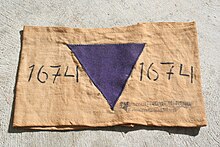User:Rtankle/wikidraft

The purple triangle was a concentration camp badge used by the Nazis to identify Bibelforscher (the German name for Jehovah's Witnesses and other Bible Students congregations) in Nazi Germany. A small number of Adventists, Baptists and pacifists (less than one percent) were also identified by the badge.[1] Nazism opposed unorthodox-Christian religious minorities (along with Jews), but made the Bible Students the object of particularly intense persecution, including such extensive incarceration that a distinct badge was assigned to them.[2][3]
Why Jehovah's Witnesses Did Not Salute Hitler[edit]
Jehovah’s Witnesses were discovered easily as they did not deny their God or who they were, making them easy targets to capture and label. All citizens, Jehovah’s Witnesses among them, were asked to salute Hitler with the traditional Hitler Salute - “Heil Hitler,” a term which means “salvation belongs to Hitler.” Since Jehovah’s Witnesses believe in the salvation of their God, Jehovah, saluting a person as a god or rendering salvation from someone or something other than Jehovah would be a form of idolatry, one of the many practices warned against in the Ten Commandments set out in the Bible. Jehovah’s Witnesses use the New World Translation of the Holy Scriptures. In the book of Exodus chapter 20, verse three it reads, “You must not have any other gods before me.” [4]Jehovah’s Witnesses are taught to obey the civil laws of the land, except when it conflicts with their faith. Since “having no other gods” was a direct command from Jehovah, saluting Hitler would have been a direct violation against one of the Ten Commandments laid out for His people, and therefore a conflict of faith. [5]Not saluting Hitler when asked was considered a crime and the Jehovah’s Witnesses were arrested. Children attending school were expelled, detained and separated from their families. [6]Many were eventually taken to concentration camps where they were marked with the Purple Triangle.
Other Forms of Resistance[edit]
Because Jehovah’s Witnesses see themselves as members not just of this world but also of Jehovah’s Kingdom, when Germany made it mandatory for military enlistment, Jehovah’s Witnesses were persecuted because they refused to bear arms for a leader other than Jehovah. Being politically neutral, they also refused to vote in the 1936 elections, Hitler’s attempt at making the Nazi regime legitimate. [5]Jehovah’s Witnesses that did not fit the Nuremberg Laws of German descent wore a purple triangle badge superimposed upon a yellow triangle. The yellow triangle indicated that this prisoner was not only a Jehovah’s Witness, but also of Jewish descent. (The Nuremberg Laws classified “Jews” as a race, not a religion.)
See also[edit]
- Identification in Nazi camps
- Nazi concentration camp badges
- Persecution of Jehovah's Witnesses in Nazi Germany
- Religion in Nazi Germany
References[edit]
- ^ Johannes S. Wrobel, Jehovah’s Witnesses in National Socialist Concentration Camps, 1933 – 45, Religion, State & Society, Vol. 34, No. 2, June 2006, pp. 89-125 "The concentration camp prisoner category ‘Bible Student’ at times apparently included a few members from small Bible Student splinter groups, as well as adherents of other religious groups which played only a secondary role during the time of the National Socialist regime, such as Adventists, Baptists and the New Apostolic community (Garbe 1999, pp. 82, 406; Zeiger, 2001, p. 72). Since their numbers in the camps were quite small compared with the total number of Jehovah’s Witness prisoners, I shall not consider them separately in this article. Historian Antje Zeiger (2001, p. 88) writes about Sachsenhausen camp: ‘In May 1938, every tenth prisoner was a Jehovah’s Witness. Less than one percent of the Witnesses included other religious nonconformists (Adventists, Baptists, pacifists), who were placed in the same prisoner classification.’".)
- ^ MoreOrLess. "Bibelforscher". Cesnur.org. Retrieved 2012-12-29.
- ^ "Holocaust Revealed". Holocaust Revealed. Retrieved 2012-12-29.
- ^ “Online Books That Help You Study the Bible.” JW.ORG. Accessed January 26, 2014. http://www.jw.org/en/publications/books/.
- ^ a b King, Christine. “Leadership Lessons from History: Jehovah’s Witnesses.” The International Journal of Leadership in Public Services 7, no. 2 (2011): 178–185. doi:10.1108/17479881111160168
- ^ The Schoolgirl The Nazis and The Purple Triangles, 2013. http://www.youtube.com/watch?v=lykM5ePGPpc&feature=youtube_gdata_player.
External links[edit]
- US Holocaust Memorial Museum summary
- "Jehovah's Witnesses in Germany" University of Minnesota's Center for Holocaust and Genocide Studies
- "Jehovah's Witnesses in National Socialist concentration camps, 1933-45, by Johannes S. Wrobel, Religion, State and Society vol. 34, no. 2 (June 2006), 89-125
- Purple Triangles: A Story of Spiritual Resistance by Jolene Chu, originally published in Judaism Today, No. 12, Spring 1999
- Purple Triangle: An Untold Story of the Holocaust
- Sustained Through Terrible Trials by Éva Josefsson, The Watchtower June 1, 1998
- Jehovah's Witnesses: Courageous in the Face of Nazi Peril, Awake! July 8, 1998
- They Triumphed Over Persecution, The Watchtower March 1, 2003
- Garbe, Detlef (Detlef Garbe 2008). Between Resistance and Martyrdom: Jehovah's Witnesses in the Third Reich. Washington, DC, and Madison, Wisconsin: United States Holocaust Memorial Museum in association with University of Wisconsin Press.
{{cite book}}: Check date values in:|year=(help) - Watchtower Bible and Tract Society (Distributor) (1991). Purple Triangles (VHS). United States of America: Starlock Pictures.
Category:Terminology of Nazi concentration camps
Category:Persecution of Jehovah's Witnesses
Category:1938 introductions
Category:Triangles
